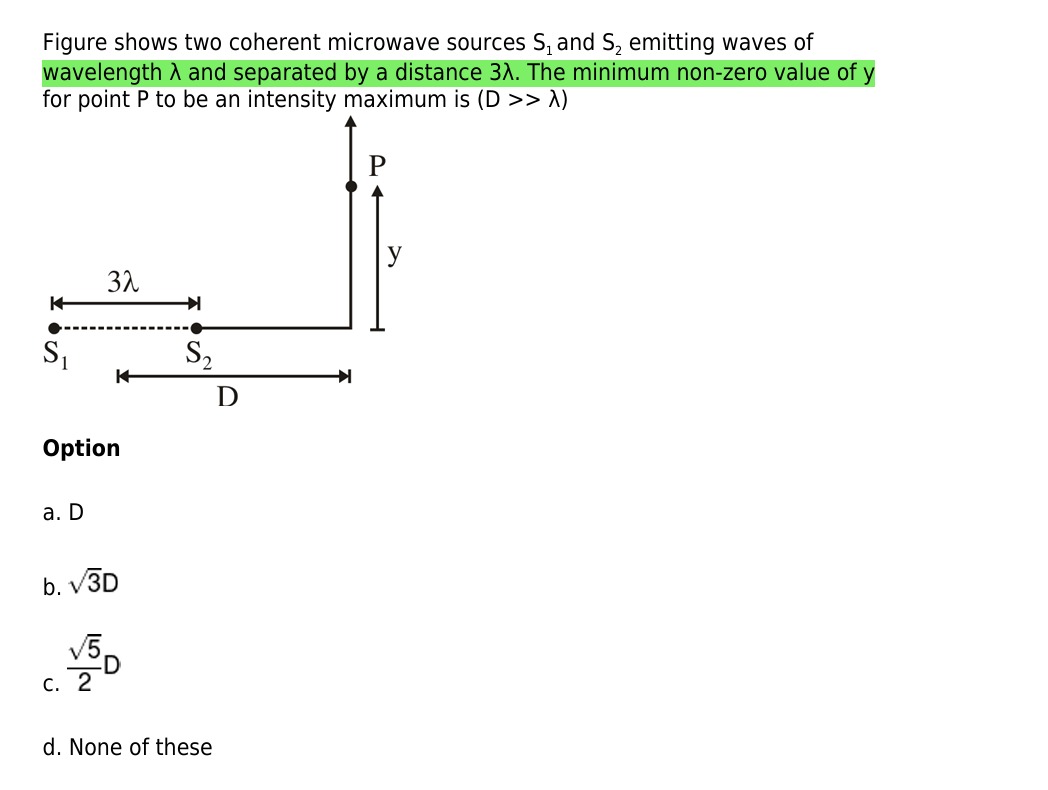Question
Question: Figure shows two coherent microwave sources $S_1$ and $S_2$ emitting waves of wavelength $\lambda$ a...
Figure shows two coherent microwave sources S1 and S2 emitting waves of wavelength λ and separated by a distance 3λ. The minimum non-zero value of y for point P to be an intensity maximum is (D >> λ)

D
3D
25D
None of these
25D
Solution
The path difference between the waves from S1 and S2 to point P is given by Δr=r1−r2, where r1 is the distance from S1 to P and r2 is the distance from S2 to P.
Let S2 be at the origin (0, 0). Then S1 is at (−3λ,0) and P is at (D,y). r1=(D−(−3λ))2+(y−0)2=(D+3λ)2+y2 r2=(D−0)2+(y−0)2=D2+y2
For constructive interference (intensity maximum), the path difference must be an integer multiple of the wavelength: r1−r2=nλ, where n=0,1,2,.... (D+3λ)2+y2−D2+y2=nλ (D+3λ)2+y2=D2+y2+nλ
Square both sides: (D+3λ)2+y2=(D2+y2+nλ)2 D2+6Dλ+9λ2+y2=(D2+y2)+(nλ)2+2nλD2+y2 D2+6Dλ+9λ2+y2=D2+y2+n2λ2+2nλD2+y2 6Dλ+9λ2−n2λ2=2nλD2+y2
Divide by λ (assuming λ=0): 6D+9λ−n2λ=2nD2+y2 6D+(9−n2)λ=2nD2+y2
Square both sides: (6D+(9−n2)λ)2=(2nD2+y2)2 36D2+12D(9−n2)λ+(9−n2)2λ2=4n2(D2+y2) 36D2+12D(9−n2)λ+(9−n2)2λ2=4n2D2+4n2y2 4n2y2=36D2−4n2D2+12D(9−n2)λ+(9−n2)2λ2 4n2y2=(36−4n2)D2+12D(9−n2)λ+(9−n2)2λ2
We are given D>>λ. We are looking for the minimum non-zero value of y. Let's analyze the equation for different values of n. For n=0, 0=36D2+108Dλ+81λ2=(6D+9λ)2. This implies 6D+9λ=0, which is not possible for positive D and λ. So n=0 does not give a solution for y.
For n=1: 4(1)2y2=(36−4(1)2)D2+12D(9−12)λ+(9−12)2λ2 4y2=(36−4)D2+12D(8)λ+(8)2λ2 4y2=32D2+96Dλ+64λ2 y2=8D2+24Dλ+16λ2 y=8D2+24Dλ+16λ2. Since D>>λ, y≈8D2=8D=22D.
For n=2: 4(2)2y2=(36−4(2)2)D2+12D(9−22)λ+(9−22)2λ2 16y2=(36−16)D2+12D(5)λ+(5)2λ2 16y2=20D2+60Dλ+25λ2 y2=1620D2+1660Dλ+1625λ2 y2=45D2+415Dλ+1625λ2 y=45D2+415Dλ+1625λ2. Since D>>λ, y≈45D2=45D=25D.
For n=3: 4(3)2y2=(36−4(3)2)D2+12D(9−32)λ+(9−32)2λ2 36y2=(36−36)D2+12D(0)λ+(0)2λ2 36y2=0 y=0. This is a possible solution for n=3, but we are looking for a non-zero value of y.
For n=4: 4(4)2y2=(36−4(4)2)D2+12D(9−42)λ+(9−42)2λ2 64y2=(36−64)D2+12D(9−16)λ+(9−16)2λ2 64y2=−28D2−84Dλ+49λ2 Since D>>λ, the term −28D2 dominates the right side, which is negative. Thus, y2<0, which means there is no real solution for y when n=4. In general, for n≥3, 36−4n2≤0. If 36−4n2<0, then the term (36−4n2)D2 is negative and proportional to D2. The other terms are proportional to Dλ or λ2. Since D>>λ, the term proportional to D2 will dominate. For y2 to be non-negative, we need (36−4n2)D2+12D(9−n2)λ+(9−n2)2λ2≥0. If 36−4n2<0, i.e., n2>9, then for large D, the term (36−4n2)D2 is a large negative number, while the other terms are of lower order in D. So for n≥4, y2 will be negative. Thus, the possible positive integer values of n are 1 and 2.
For n=1, y≈22D≈2.828D. For n=2, y≈25D≈1.118D. The minimum non-zero value of y occurs for n=2, and is approximately 25D.
Let's check the exact values. For n=1, y=8D2+24Dλ+16λ2. For n=2, y=45D2+415Dλ+1625λ2. Since D>>λ, the terms with λ are small compared to the term with D2. So the minimum value of y is indeed approximately 25D. Comparing the options, option (c) is 25D.
